How bad are Genshin Impact's microtransactions anyway?
A complete breakdown of how Genshin Impact's "gacha" systems work.
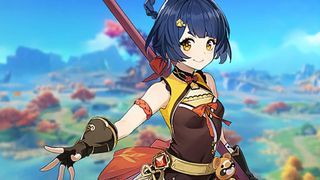
Genshin Impact's microtransactions are a little concerning. It shares some DNA with the "gacha" genre of mobile games, where loot boxes reward powerful new characters and weapons at extremely low drop rates. But Genshin Impact's emphasis on exploring a gorgeous open world and fun action RPG combat mean those microtransactions don't really get in the way of what is one of 2020's most astounding and exciting games—for the most part.
Even though Genshin Impact is great, its microtransactions are pretty damn confusing. There's a lot of currencies with long-winded names and a variety of different progression systems to level up. Deep breaths, though. This guide will not only explain the different microtransactions, the systems that encourage you to spend, and premium currencies, but it'll also explain how to get the most of this free-to-play game if you do decide to spend a little money on it.
TL;DR: How bad is it, doc?
Genshin Impact feels like the kind of game where you'll spend money because you want to, not because you feel obligated to.
Genshin Impact's microtransactions only look really bad on paper, but affect the game in such insignificant ways that they end up being inoffensive. Sure, top-tier characters only have a 0.6 percent chance to drop from loot boxes, but even without them you'll be able to see, fight, and do everything in the game. I also love that Genshin Impact isn't constantly in my face asking me to spend money like other mobile games, and it hands out free loot boxes at a fairly generous pace. Genshin Impact feels like the kind of game where you'll spend money because you want to, not because you feel obligated to.
The only system that might frustrate players is Resin, which you have to spend to get rewards from certain higher-level activities but replenishes slowly. It'll stop you from power grinding for the best loot, but there's so much to do in Genshin Impact I don't feel frustrated when I run out.
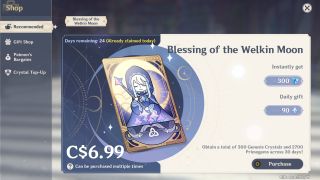
What's the best way to spend my money?
Though there's a lot to cover, the real thing you should focus on with Genshin Impact is how to maximize the amount of Fates you can get, since they'll be needed to open Wishes and get access to powerful new characters and loot. Everything else is pretty trivial and can be earned just by exploring the world. If you don't know what these items are, check out the other sections below.
Spending money on Wishes and Fates directly seems like a terrible investment, however. Two Fates will cost you around $4—and chances are you'll get nothing worthwhile from them. If you buy ten Fates and use them all at once to guarantee at least a four-star item/character, that'll cost almost $30. That's waaaaay too much.
Because of that, it's much better to spend a little money on some boosts that'll increase how often you get Fates and other in-game resources. In the Shop menu, under the Gift Shop section, you'll find an item called Blessing of the Welkin Moon that costs $5 and rewards you with 90 Primogems a day for 30 days (so 2,700 total) and 300 Genesis Crystals upfront. That's a pretty great deal compared to everything else.
The biggest gaming news, reviews and hardware deals
Keep up to date with the most important stories and the best deals, as picked by the PC Gamer team.
Another option is paying to upgrade the battle pass for $10. The rewards found within the premium tier will help you level up your characters and their items significantly faster.
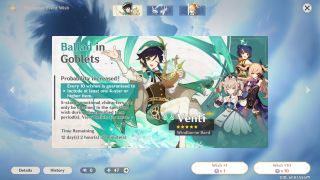
How Primogems, Fates, and Wishes work
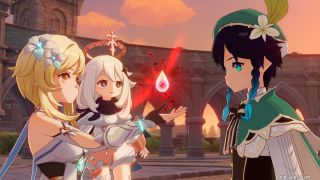
Genshin Impact guide: 9 beginner tips
Genshin Impact multiplayer: Play with friends
Genshin Impact tier list: Each character ranked
Genshin Impact Resin: How to get and spend it
Genshin Impact Lisa: Which gifts to give
Genshin Impact map: All Anemoculus locations
Most everything you do in Genshin Impact is determined by what characters you have in your party. Their elemental attacks will trigger different damage combos, and their abilities will change how you explore the open world, like being able to use Venti's Skyward Sonnet to launch himself up to unreachable heights. Early on, you'll receive several characters just for completing the intro but the rest come from loot boxes. It's a little confusing, so let me explain.
Wishes are like seasonal loot box events that offer different rewards—typically a mix of characters and weapons of rarer qualities. Each Wish event requires a certain type of Fate to open, which are little orbs you sometimes get from different activities, like the battle pass. When you spend a Fate on a Wish, you earn either a new item or, if you're lucky, a character.
Fates can sometimes be given as rewards, but more often than not you'll buy them for 160 Primogems which are earned by doing basically anything in the game. Opening chests, fighting bosses, completing quests, progressing your Adventure Rank, logging in every day—there's a ton of ways to earn Primogems.
Can I get duplicates of the same character?
Yes, but it's actually a good thing. You can only ever have one of each character in your party (this isn't like Pokemon), but every character has a special skill tree called a Constellation that includes some pretty significant upgrades to their abilities. In order to unlock these buffs, however, you need to get a special item that is earned by getting a duplicate of that same character from a Wish. So to unlock Xianling's Crispy Outside, Tender Inside buff, I have to first get a duplicate of her. At no point will I ever have two Xianlings, though.
Getting duplicates of the same item is a little similar but less consequential. Though you'll often get new weapons from Wishes, you'll find loads more while exploring and opening chests. Most of that will be broken down and used to enhance the stats of more powerful gear.
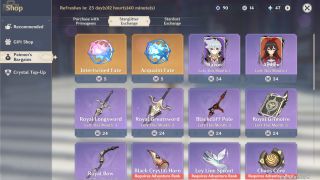
What is Starglitter and Stardust?
So every time you spend a Fate to open a Wish, you'll also get a little bit of Stardust and, if you're lucky, some Starglitter too. Each of these is a special currency that can be used in the Paimon's Bargains section of the Shop found in the main menu. If your Wish contains a three-star item, you'll get a little bit of Stardust, but if it contains a four-star or higher item or character, you'll get some Starglitter instead.
Think of Stardust and Starglitter as points you earn from your grocery store membership. As you open Wishes, you'll eventually earn enough of these points to get a little something extra.
You can buy a variety of rare items for Stardust or Starglitter, but you should probably just save it up to spend it on more Wishes or characters. In Paimon's Bargains, you can spend Stardust to buy up to five of each type of Fate per month. Starglitter, however, can be saved up to buy characters or high-quality weapons directly. So even if you have bad luck with Wishes, you should eventually be able to buy the item or character you're after.
What else should I know about microtransactions?
The only other thing we haven't covered is Genesis Crystals which are the premium currency you can only buy with real money. Genesis Crystals can be spent on some resource packs or converted to Primogems to buy more Fates.
There's also a battle pass that you unlock at Adventure Rank 20 (that'll take several hours to do), that pretty much works like every other battle pass. You rank up and earn rewards by completing daily, weekly, and monthly missions. There's a free version that has some pretty decent rewards, or you can upgrade it for $10 to access the premium track that triples the loot you get at each battle pass level. You can also buy levels for Primogems, and there's a special package which costs about $25 and includes some rare loot and also immediately bumps you up to battle pass level 10.
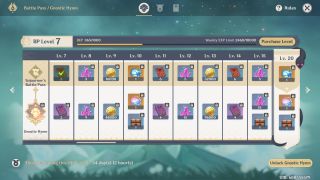
What's Resin and how does that work?
Certain activities in Genshin Impact, like Ley Line Outcrops and dungeons, only give rewards if you first spend Resin. This is a resource that regenerates fully every 15 hours but can be quickly topped off with a special item you earn from certain quests or purchase directly.
You start with 120 Resin and most activities will cost between 20 to 60 depending on the quality of the loot you can get. So you'll be able to do a few of these activities each day but will have to spend money if you want to power grind them.
With over 7 years of experience with in-depth feature reporting, Steven's mission is to chronicle the fascinating ways that games intersect our lives. Whether it's colossal in-game wars in an MMO, or long-haul truckers who turn to games to protect them from the loneliness of the open road, Steven tries to unearth PC gaming's greatest untold stories. His love of PC gaming started extremely early. Without money to spend, he spent an entire day watching the progress bar on a 25mb download of the Heroes of Might and Magic 2 demo that he then played for at least a hundred hours. It was a good demo.
Most Popular

